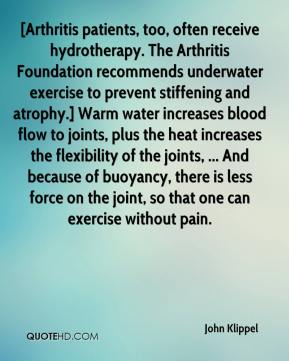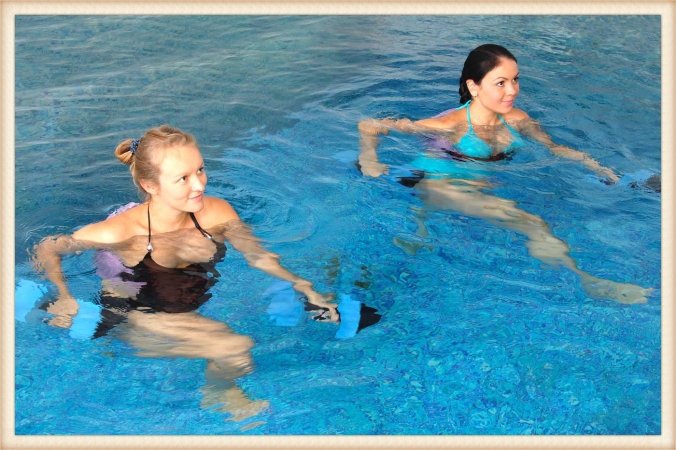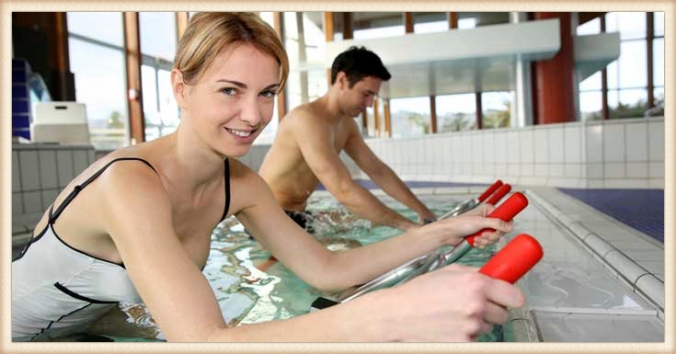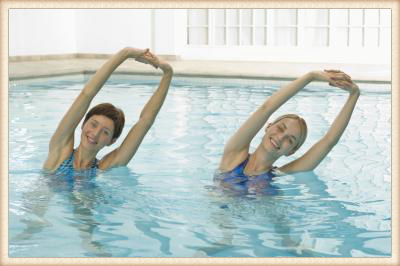The Alternative Therapy for Rheumatoid Arthritis
If painful joints are not letting you exercise, all is not lost. If you are convalescing from an illness and wish to work out, do not lose hope. You can look to water for help, hydrotherapy will come to your aid. The world over, there are thousands afflicted by different kinds of pains, particularly osteo-arthritis and rheumatoid arthritis and they work out under water. Hydrotherapy is a blessing to aching muscles and inflamed joints.
What is hydrotherapy?
Hydrotherapy is the use of water to treat a disease, pain or to maintain health, where the body is immersed at various depths. Water is proven to have many healing properties :
- Water can store and carry heat and energy.
- Water can dissolve other substances, such as minerals and salts.
- Water cannot hurt you, even if you are sensitive to your surroundings.
- Water is found in different forms, such as ice, liquid, or steam. Ice may be used to cool, liquid is used in baths and compresses at varying pressures or temperatures, and steam is used in steam baths, or in inhalations.
- Water can help blood flow.
- Water has a soothing, calming, and relaxing effect on people, whether in a bath, shower, spray, or compress.
- Exercise in water takes the weight off a painful joint while also providing resistance.
The benefits of exercising in water
Some of the benefits of water exercise include:
- Increased muscle strength, posture and balance
- Enhanced sense of wellbeing, mood and sleep quality
- Greater mobility and flexibility of joints
- Improved endurance and fitness
- Eases stiff joints and relaxes sore muscles
- Reduced pain and fatigue (tiredness)
Ask regular swimmers, they will tell you how a general feeling of wellness sweeps over them, every time they do their laps. Why, even beginners have reported feeling light in their bodies and energetic after their dips. Hydrotherapy differs from swimming in that it involves special exercises done in relatively warm water with a specified water temperature.
You don’t have to give up cycling for painful joints, cycle under water! The picture below is only illustrative to bring home the point.
What is hydrotherapy used for?
Hydrotherapy is used to treat many conditions, but we are going to focus in this article on arthritis, joint muscle and nerve problems. Other conditions that can be alleviated through hydrotherapy are acne, colds, depression, headaches and stomach problems. Tepid water can stimulate stress–reducing hormones, while cold water is harnessed to reduce inflammation. Alternating hot and cold water is known to stimulate blood circulation and improve immunity. Hydrotherapy is safe and an ideal way to exercise during pregnancy and for the advanced in age – blog posts on that coming soon.

Image Courtesy : John Kippel Quotes
In many hydrotherapy treatments, herbs and essential oils are added in steam and sauna treatments, with steam as a carrier of essential oils – to be inhaled to treat respiratory issues. Since the late 1990s, it is even being used in critical care units that targets a variety of conditions, including disorders of the nervous system like the Guillain-Barre syndrome. In other cases, to infuse a general feeling of well-being similar to therapies in spas.
How safe is hydrotherapy?
Generally safe if administered properly by trained therapists. A discussion with your doctor is however a must before you opt for hydrotherapy. Different people react and respond differently to it, just like most other treatments. We must remember that hydrotherapy is an alternative therapy, at most it can compliment the primary medical therapy. Hence it is not advisable to forego your conventional medical therapy.
While hydrotherapy works wonders for general fitness and flexibility, certain conditions like arthritis and rheumatism show tremendous improvement. In some cases, it has helped avoid surgeries.
How does hydrotherapy work for arthritis and rheumatism?
- Since the temperature of the water in the pool is regulated and monitored, the warmth of the water aids in letting your muscles relax and eases pain in your muscles/joints. It is best to first condition your body in the tepid or warm water by just wading, walking around or just being, before you begin proper exercises.
- Water supports your weight and allows you to increase your range of movement of your joints.
- Water provides resistance, hence by pushing or lifting your arms and legs against water will result in improved muscle strength.
- Hydrotherapy exercises can be customised to target specific parts of your body and keeping in mind your medication.
- Activities such as stretching or walking through water can exercise the joints without putting them under strain.
There are scientific studies to show that hydrotherapy benefits arthritic and rheumatism patients hugely. Back pain is another condition that can be treated effectively with hydrotherapy.
An excerpt from an article on Aqua-therapy by Dr Kannan Pugazhendi, the reputed sports-medicine specialist of Chennai, who recently has been awarded the ‘Distinguished Doctor’ by the Rocheston Accreditation Institute, New York : It promotes blood circulation to the joints and all other parts of the body by means of Hydrostatic pressure through which pain can be alleviated. Strengthening of weaker muscles and increase in balancing capacity can be obtained by fluid resistance (viscosity) of the water, i.e. moving the part of the body immersed in water.
Water has the property to absorb heat 1000 folds more than air. Therefore, exercising in the water helps to burn more calories resulting in reduced body fat as compared to working out on land. On the other hand, water is competent to conduct heat to the immersed body 25 times faster than air which alters the sweaty mechanism and promotes peripheral circulation with less physical activity.
A word of caution : Since water provides that extra support, one is likely to overdo the exercises. Consult your physiotherapist or even better, work under his/her supervision till you have understood your capacity and are well on your way to recovery.
You don’t know swimming? No sweat!
The pool is quite shallow in most cases (about chest height). Some pools come in gradient heights, so you can exercise in your comfort zone. Steps that lead you down into the pool along with handrails offer support if you do not feel like a fish! Either way, water is fun and soothing to be in, so make the best of it.
When is hydrotherapy not advisable?
Certain health conditions may either not permit hydrotherapy or are best avoided for reasons of hygiene. At all times, inform your physiotherapist should you have these issues:
- A wound or skin infection
- A virus or stomach upset
- A raised temperature
- High or low blood pressure
- Breathing difficulties
- A kidney condition requiring dialysis
- Angina or heart problems
- Incontinence
- A chest infection
- Chlorine allergy
- Uncontrolled diabetes, asthma or epilepsy.
How long should hydrotherapy continue?
At the end of the prescribed course of hydrotherapy with your therapist, you will have gained a certain amount of confidence, and the healing would have been in process. Your therapist will then suggest that you continue with the prescribed exercises on your own.
Some pools have designated timings when the temperature of the water is raised to facilitate hydrotherapy sessions. Sign up for those hours. Now that you are comfortable in water, take swimming lessons if you are a novice, it is a wonderful exercise that builds your stamina, tones your muscles and whats more, is a fun way to exercise.
Safety suggestions
And finally learn to be safe:
- Have your therapist by your side, but a good way to warm up is to swim gently or go for a ‘walk’ through the water.
- Building up fitness is a gradual process, so begin with no more than 20 minutes of exercise in the beginning.
- If you feel light-headed, sick or dizzy at any stage, get out of the water.
- Don’t rush yourself, if you feel out of breath, slow down.
- Perform each movement as gracefully and smoothly as you can.
- Keep the body part you are exercising under the water. This may require you to squat or bob down at times.
- If a movement causes pain or discomfort, stop immediately.
- Drink plenty of fluids during and after exercising.
- If you have painful joints or sore muscles for more than a few hours after your class, try to go a little slower next time.
I have written this blog post to create awareness about hydrotherapy and to make a difference to those who find it difficult to exercise due to rheumatoid arthritis and the like. Please do share it with people you think that need this info and of course your comments and feedback is eagerly awaited.




@philipcambodia, thank you for the like 😊
LikeLike
Good summary. I have RA and a pool and have still ignored this therapy. You’ve pushed me the right direction.
LikeLike
@Jacqui Murray, feels good to know that my post has inspired someone. My passion is to share wellness just as yours is to spread love of English language. Time to get into the pool !
LikeLike
very comprehensive post, and worth passing along, thanks! this is a perfect reminder for my mother-in-law!
LikeLike
Thank you Roxie for your comment. Please do pass it on, it’s my way of making a difference to this world- sharing health and wellness tips. Hope it helps your mom in law.
LikeLiked by 1 person
Yes indeed!
LikeLike